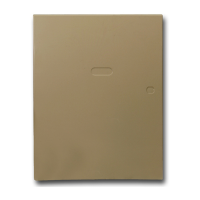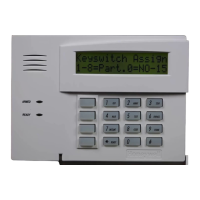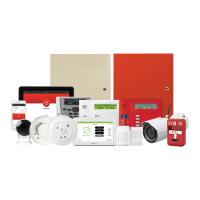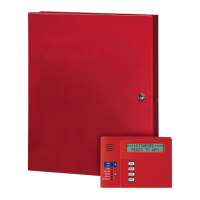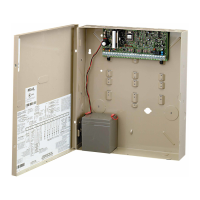Section 3 - Installing the Control
3-23
RED
BLACK
GREEN
YELLOW
CONTROL
TERMINALS
7
8
9
6
ECP RADIO
Figure 3-29: Wiring Long Range Radio to Keypad
Terminals
Supervision
The data lines between the control and the LRR, as
well as certain functions in the radio, can be
supervised.
If communication is lost or a trouble condition occurs,
both the LRR and the control’s dialer can be
programmed to send a Trouble message to the central
station.
NOTE: For complete information, see the Installation
Instructions that accompany the radio.
Trouble Messages
The following messages are displayed on the 6139/6160
when a problem exists on the Long Range Radio:
1. “LRR Battery”: The battery connected to the radio
is low.
2. “PLL out of Lock”: The radio has an internal fault
and cannot transmit any messages.
3. “Early Power Detect”: RF power is detected
without a valid transmission.
4. “Power Unattained”: Full RF power was never
attained.
5. “Frwd. Power Loss”: RF power was not sustained
throughout the transmission.
6. “Antenna Fault”: A problem with the antenna has
been detected.
7. “LRR CRC is bad”: The radio’s EEPROM is corrupt
(the internal CRC is bad).
NOTES:
Items 2 and 3 require factory service.
Items 4 and 5 could be the result of a bad or low
battery.
If the item 6 message appears, check the antenna,
connection and cable; if they are secure, factory service
is required.
All these messages are displayed in conjunction with
the “CHECK 8xx” message, which indicates a trouble
on the address to which the LRR unit is programmed
in the control.
All of these events except Antenna Fault are sent to
the event log and reported to the central station using
Contact ID Event Code 333 (expansion device trouble).
Antenna Fault uses Event Code 357. If the tamper is
tripped on the LRR, it uses Event Code 341 (expansion
device tamper).
Installing the Alpha Pager Module
The VA8201 Alpha Pager Module (APM) is used for the
transmission of alphanumeric messages to a user-
subscribed Paging Service. The APM can be
programmed to send the information to up to 8
different paging services. In addition, the module can
direct the event log reports to a parallel or serial
printer and can interface the control to a computer
equipped with Home Automation software.
U
L
The Alpha Pager Module is not permitted in UL
installations.
The types of events (messages) the pager can transmit
are divided into 5 categories: alarms, troubles,
bypasses, openings/closings, and system.
The options for each paging service are:
• Paging service phone number
• Format (numeric, alphanumeric)
• Two Delay Times (numeric format only): the time
between dialing and transmitting of pager ID and
the time between pager ID and event information
• Pager ID number (if necessary)
• Partition(s) (which partitions the events are
transmitted for)
• Types of messages (events) sent. Must be
programmed for the pager to work.
The APM hangs up between each message. Multiple
messages are sent in the order received. If the APM
cannot make contact with the paging service, it retries
up to 10 times.
• The APM is only required for alphanumeric
format. The system sends numeric format
messages directly.
• When using the APM, field ✳14 must be
programmed for RS232 input (1). Zone 9 can
longer be used as a protection zone.
• The APM transmits alphanumeric messages
using the TAP protocol. You must check with
the paging service to ensure that they are
using the TAP protocol Rev. 1.8 or higher.
Paging Service Advisory
If you are setting up the software for the first time,
contact your paging service provider for the following
two pieces of information:
• The exact access number to be used with each
receiving device
• The correct PIN number for each receiving device.
WWW.DIYALARMFORUM.COM
WWW.DIYALARMFORUM.COM

